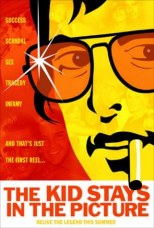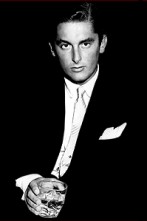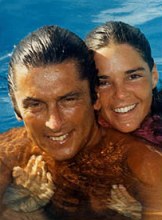|
The Kid Stays in the Picture
|
| |
 |
Documentary. USA, 2002. Rated R.
93 minutes.
Cast:
Robert Evans
Writers: Brett Morgen, based on the autobiography by Robert Evans
Music: Jeff Danna
Cinematographer: John Bailey
Editor: Jun Diaz
Producers: Brett Morgen, Nanette Burstein, Graydon Carter
Director: Brett Morgen, Nanette Burstein
LINKS
|
 here
have been few Hollywood producers as influential as legendary Paramount executive
Robert Evans--at least, to hear him tell it. The Kid Stays in the Picture,
a documentary about Evans, opens with the caption, "There are three sides to
every story, your side, my side and the truth. And no one is lying. Memories
shared serve each differently." We don't get three sides of Evans's story in
The Kid Stays in the Picture. We get only his side. Evans does his own
voiceover narration, adapted from his 1994 autobiography. Though it's clearly
a subjective account, Evans relates the events of his life clearly and without
skirting the more unpleasant episodes. It's also enormously entertaining.
here
have been few Hollywood producers as influential as legendary Paramount executive
Robert Evans--at least, to hear him tell it. The Kid Stays in the Picture,
a documentary about Evans, opens with the caption, "There are three sides to
every story, your side, my side and the truth. And no one is lying. Memories
shared serve each differently." We don't get three sides of Evans's story in
The Kid Stays in the Picture. We get only his side. Evans does his own
voiceover narration, adapted from his 1994 autobiography. Though it's clearly
a subjective account, Evans relates the events of his life clearly and without
skirting the more unpleasant episodes. It's also enormously entertaining.
Were Evans a rock star instead of a Hollywood producer, his story would perfectly
suit an episode of VH1's Behind the Music. Everyone knows the five-act
Behind the Music structure by now (so much so that it has been mocked
on Saturday Night Live): the Charmed Early Days, the Meteoric Rise, the
Fall, the Dark Times, and the Redemption. The Kid Stays in the Picture
follows that general structure, though with more emphasis on the first three
acts than the last two. Everything is operatically writ large.
Although he had dabbled in show biz, Evans was a millionaire businessman by
the age of twenty-five. He was discovered quite improbably as he was doing business
by the pool of the Beverly Hills Hotel, where he caught the eye of Oscar-winner™
Norma Shearer, who insisted that he appear as her husband, legendary producer
Irving Thalberg, in The Man of a Thousand Faces. (Hm, she must have liked
the way Evans looked in a swimsuit.) A handful of films followed, including
a role as a bullfighter in The Sun Also Rises.  The
casting of the unknown Evans caused an open revolt by virtually everyone involved
in the project, according to Evans. Overriding them, the words of producer Darryl
Zanuck give The Kid Stays in the Picture its title.
The
casting of the unknown Evans caused an open revolt by virtually everyone involved
in the project, according to Evans. Overriding them, the words of producer Darryl
Zanuck give The Kid Stays in the Picture its title.
"Half-assed" acting, as he puts it, was not really Evans's bag, though. What
he really wanted to do was produce. That career came to him as quickly and easily
as acting. At the unprecedented young age of 34, without ever having produced
a finished picture, Hollywood's "Golden Boy"was ensconced as the chief of production
of struggling Paramount Pictures. Rosemary's Baby, The Odd Couple, Love Story,
and other classics followed, including a little picture entitled The Godfather.
What emerges from these stories is that Evans was the consummate risk-taker.
To hear Evans tell it, the evolution of cinema in the late '60s and early '70s
never would have happened without him. He never says as much, of course, and
though he's probably exaggerating his own importance, it's clear his role was
key.
The 1970s saw Evans branching out on his own as a producer (Chinatown)
while remaining at Paramount, as well as dating (and sometimes marrying) every
young woman who was anyone in Hollywood, until he hit the inevitable cocaine-saturated
Dark Times. The Kid Stays in the Picture concludes with the beginning
of Evans's modest comeback, highlighted by producer credits on The Saint
and Sliver, both box office successes.
Despite the hackneyed story structure, The Kid Stays in the Picture
never seems to tread on worn ground. A big part of the reason is that Evans
is a vibrant raconteur. He energetically weaves his stories exactly as
he would if you were sitting with him at the dinner table. He doesn't just narrate;
he tells his life as a series of linked anecdotes, each with its own dynamics.
Evans is such a capable storyteller that you find yourself liking him even though
he's not exactly likeable. You wouldn't want to share your life with the guy,
but you'd sure like to hang out with him for an evening.
Another reason The Kid Stays in the Picture amounts to much more than
just a pile of Hollywood clichés is that Evans himself never makes any false
claims about having found redemption; he never claims to be sober and optimistic;
 he
never says any of that hollow-sounding stuff that the rock stars always say
at the end of Behind the Music. Neither is Evans an apologist for his
life. He tells it like it was, from his perspective, freely admitting to his
weaknesses, screw-ups, and gigantic ego.
he
never says any of that hollow-sounding stuff that the rock stars always say
at the end of Behind the Music. Neither is Evans an apologist for his
life. He tells it like it was, from his perspective, freely admitting to his
weaknesses, screw-ups, and gigantic ego.
Producers/directors Brett Morgen and Nanette Burstein use Evans's luxuriant
Beverly Hills house, "Woodland," as a metaphor for his life. At the beginning
and the end, as well as a handful of key junctures, the camera moves though
his home meditatively, studying the artifacts of Evans's life. It becomes evident
that the house is an extension of Evans's identity, so much so that when he
had to sell it (continuing to live there as a tenant), Jack Nicholson himself
went to beg the new owner to let Evans buy his house back. Evans is more intimate
with his house than with any woman--his longest relationship was a three-year
marriage to Ali McGraw, and he recently was married for twelve days to Catherine
Oxenberg--but he's lived in that house thirty-five years. He describes it almost
sensually.
The rest of the film is a montage of film clips, archival footage, and photographs.
Lots and lots of photographs. Almost every moment of Evans's life, it seems,
was photographed. Often several photographs of the same moment are presented
sequentially, giving the sensation of movement. Other times, the subjects of
the photograph are digitally manipulated to look like cardboard cutouts so that
the camera can flow among them. This highly effective editing defeats the static
feel that encumbers so many documentaries.
The reasons for Evans's success are multifold, but two stand out: his seductiveness
and his sense for what makes a great story. The Kid Stays in the Picture
may describe Evans's life, but it is Evans himself who demonstrates what made
him a legendary producer, because both those qualities are manifest in his narration.
His career was meteoric, but Evans was no shooting star. His time at the top
was long, and though he faced many challenges and a precipitous fall, Evans
has always stayed in the picture.
Review
© July 2002 by AboutFilm.Com and the author.
Images © 2002 USA Films. All Rights Reserved.

 The
casting of the unknown Evans caused an open revolt by virtually everyone involved
in the project, according to Evans. Overriding them, the words of producer Darryl
Zanuck give The Kid Stays in the Picture its title.
The
casting of the unknown Evans caused an open revolt by virtually everyone involved
in the project, according to Evans. Overriding them, the words of producer Darryl
Zanuck give The Kid Stays in the Picture its title.
 he
never says any of that hollow-sounding stuff that the rock stars always say
at the end of Behind the Music. Neither is Evans an apologist for his
life. He tells it like it was, from his perspective, freely admitting to his
weaknesses, screw-ups, and gigantic ego.
he
never says any of that hollow-sounding stuff that the rock stars always say
at the end of Behind the Music. Neither is Evans an apologist for his
life. He tells it like it was, from his perspective, freely admitting to his
weaknesses, screw-ups, and gigantic ego.
